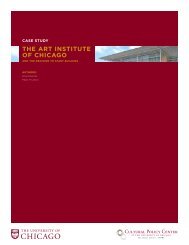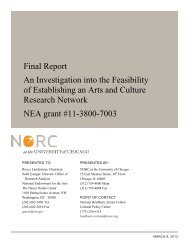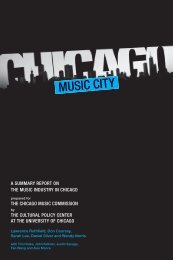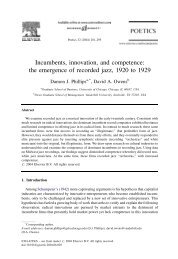Mapping Cultural Participation in Chicago - Cultural Policy Center
Mapping Cultural Participation in Chicago - Cultural Policy Center
Mapping Cultural Participation in Chicago - Cultural Policy Center
Create successful ePaper yourself
Turn your PDF publications into a flip-book with our unique Google optimized e-Paper software.
RecommendedReferencesSurvey ResearchThe Arts Market<strong>in</strong>g <strong>Center</strong>. 1999. Barriers and Motivations to Increased Arts Usageamong Medium and Light Users. <strong>Chicago</strong>: Arts & Bus<strong>in</strong>ess Council of <strong>Chicago</strong>.DiMaggio, Paul and Francie Ostrower. 1992. Race, Ethnicity and <strong>Participation</strong> <strong>in</strong> the Arts:Patterns of <strong>Participation</strong> by Hispanics, Whites, and African Americans <strong>in</strong> SelectedActivities from the 1982 and 1985 Surveys of Public <strong>Participation</strong> <strong>in</strong> the Arts. SantaAna: Seven Locks Press.Hendon, William S. 1990. “The General Public’s <strong>Participation</strong> <strong>in</strong> Art Museums: VisitorsDiffer from Non-Visitors, but Not as Markedly as Case Studies Have Indicated.” TheAmerican Journal of Economics and Sociology 49 (4):439-457.Metro <strong>Chicago</strong> Information <strong>Center</strong> (MCIC). 2005. Arts <strong>Participation</strong> <strong>in</strong> the Metropolitan<strong>Chicago</strong> Region: Grow<strong>in</strong>g Audiences <strong>in</strong> a Region of <strong>Cultural</strong> Over-Achievers. <strong>Chicago</strong>:Metro <strong>Chicago</strong> Information <strong>Center</strong>.National Endowment for the Arts. 1984. Studies of the Arts Public: A Status Report.Research Division, Note 8.— . 1985. Audience Crossover: Media <strong>Participation</strong> and Attend<strong>in</strong>g Live Events. ResearchDivision, Note 12.— . 1986. Age, Desire, and Barriers to Increase Attendance at Perform<strong>in</strong>g Arts Events andArt Museums. Research Division, Note 14.— . 1986. Population Location and the Barriers of ‘Art Form Not Available’ and ‘Too FarTo Go.’ Research Division, Note 18.— . 1986. Public <strong>Participation</strong> <strong>in</strong> the Arts by Urban and Rural Residence. ResearchDivision, Note 18.— . 1987. Public <strong>Participation</strong> <strong>in</strong> the Arts: 1982 and 1985 Compared. Research Division,Note 27.— . 1993. Public <strong>Participation</strong> <strong>in</strong> the Arts: 1982 and 1992. Research Division, Note 50.— . 1994. Demographic Differences <strong>in</strong> Arts Attendance: 1982-1992. Research Division,Note 51.— . 1994. Demographic Differences <strong>in</strong> Arts <strong>Participation</strong> via Broadcast and RecordedMedia: 1982-1992. Research Division, Note 52.— . 1995. Public <strong>Participation</strong> <strong>in</strong> the Arts <strong>in</strong> Regional and Metropolitan Areas, 1982-1992.Research Division, Note 55.— . 1999. “Executive Summary.” 1997 Survey of Public <strong>Participation</strong> <strong>in</strong> the Arts: SummaryReport. Research Division, Report 39:http://www.arts.gov/pub/Researcharts/Summary39.html (accessed July 7, 2004).— . 1999. Demographic Characteristics of Arts Attendance, 1997. Research Division, Note71. http://www.arts.gov/pub/Notes/71.pdf (accessed July 7, 2004).Putnam, Robert D. 1995. “Bowl<strong>in</strong>g Alone: America’s Decl<strong>in</strong><strong>in</strong>g Social Capital.” Journal ofDemocracy 6: 65-77.Theoretical frameworksBalfe, Judith Hugg<strong>in</strong>s and Margaret Wyszomirski. 1990. “The Political Consequences ofNon-<strong>Participation</strong> <strong>in</strong> the Arts.” Paper presented at the annual meet<strong>in</strong>g of theInternational Sociological Association.57









